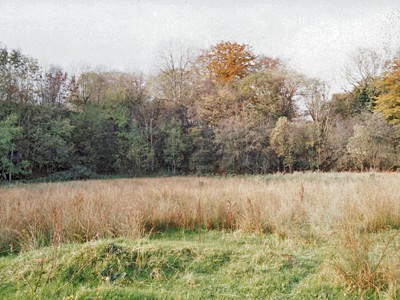Earth Science Conservation Review
| Bellanaleck Quarry | Fermanagh |
| Site Type: | Quarry (disused) |
| Site Status: | ASSI |
| Council area: | Fermanagh District Council |
| Grid Reference: | H234389 |
| Google maps: | 54.29882,-7.64057 |
| Rocks | |
|---|---|
| Rock Age: | Carboniferous (Courcyean, Tournasian) |
| Rock Name: | Tyrone Group |
| Rock Type: | Limestone |
| Interest | |
| Minerals: | Sparrite |
| Fossil Groups: | Brachiopod, Coral, Foraminifera, Goniatite, Microfossil, Microfossils, Polyzoan, Trilobite |
| Other interest: | Marine sediments |
Summary of site:
About 340 million years ago, the area that is now Bellanaleck in Co. Fermanagh was a shallow, ocean covered margin of a huge continental crustal plate drifting northwards across the equator at an infinitesimally slow pace. In this ocean, at a depth barely penetrated by light, mounds of mud were building up on the sea bed by a process still not fully understood. The surface of the mounds was heavily colonized by a range of organisms specially adapted to these conditions. At least 20 species of lamp shells (brachiopods), sea lilies (crinoids), a coral, sea mosses (fenestellid bryozoa), a goniatite, five species of trilobites and a limited range of microfossils have been found. The sea mosses encrusted most of the flanks of each mound, creating microhabitats for the other inhabitants, with sea lilies and trilobites thriving in the shallower waters of their summits.
This is the interpretation of the 10-12m of grey fine-grained limestones exposed on the west side of Bellanaleck Quarry. There is feeble evidence of bedding in these rocks at the north end of the face where surfaces inclined to the north at 30 degrees are presumed to represent the slope of the flanks of the mound. The rock is seamed by thin laminations of calcite almost always around the fronds of bryozoa (of the fenestellid group - delicate lace-like animal colonies with an inverted cone shape). Many of the lamp shells appear to be in their position of growth, finely preserved with their valves still joined.
The specialised fauna of these mud mounds survived for around 10 million years and so is of limited use for precise dating, but at this locality some microscopic foraminifera suggest an early Chadian lower age limit while a species of trilobite sets a late Chadian upper limit. Chadian rocks are very uncommon in Northern Ireland, with only one other site known. The mounds themselves are also important because they belong to the Waulsortian facies, as defined in Belgium in the late nineteenth century for mud mounds of middle Tournaisian to early Visean age. In Ireland such mounds appeared in the south during the late Tournaisian and none survived the Chadian.
The site is one of the most important of the wide range of Carboniferous sites in Northern Ireland because: 1, it is one of only two examples of Waulsortian facies known here; 2, it extends northwards the previously supposed limit of the Waulsortian in Ireland by 60 km; 3, it is the only site with a definite early Chadian component; 4, it is the only site containing the diagnostic trilobite fauna; and 5, it sets the most northerly limit of the Waulsortian in Western Europe.
This is the interpretation of the 10-12m of grey fine-grained limestones exposed on the west side of Bellanaleck Quarry. There is feeble evidence of bedding in these rocks at the north end of the face where surfaces inclined to the north at 30 degrees are presumed to represent the slope of the flanks of the mound. The rock is seamed by thin laminations of calcite almost always around the fronds of bryozoa (of the fenestellid group - delicate lace-like animal colonies with an inverted cone shape). Many of the lamp shells appear to be in their position of growth, finely preserved with their valves still joined.
The specialised fauna of these mud mounds survived for around 10 million years and so is of limited use for precise dating, but at this locality some microscopic foraminifera suggest an early Chadian lower age limit while a species of trilobite sets a late Chadian upper limit. Chadian rocks are very uncommon in Northern Ireland, with only one other site known. The mounds themselves are also important because they belong to the Waulsortian facies, as defined in Belgium in the late nineteenth century for mud mounds of middle Tournaisian to early Visean age. In Ireland such mounds appeared in the south during the late Tournaisian and none survived the Chadian.
The site is one of the most important of the wide range of Carboniferous sites in Northern Ireland because: 1, it is one of only two examples of Waulsortian facies known here; 2, it extends northwards the previously supposed limit of the Waulsortian in Ireland by 60 km; 3, it is the only site with a definite early Chadian component; 4, it is the only site containing the diagnostic trilobite fauna; and 5, it sets the most northerly limit of the Waulsortian in Western Europe.
| Enlander, I., Dempster, M. & Doughty, P., 2025. Bellanaleck Quarry, County Fermanagh, site summary. [In] Earth Science Conservation Review. https://www.habitas.org.uk/escr/summary.php?item=177. Accessed on 2025-04-03 |
| Previous Site | Next Site |
